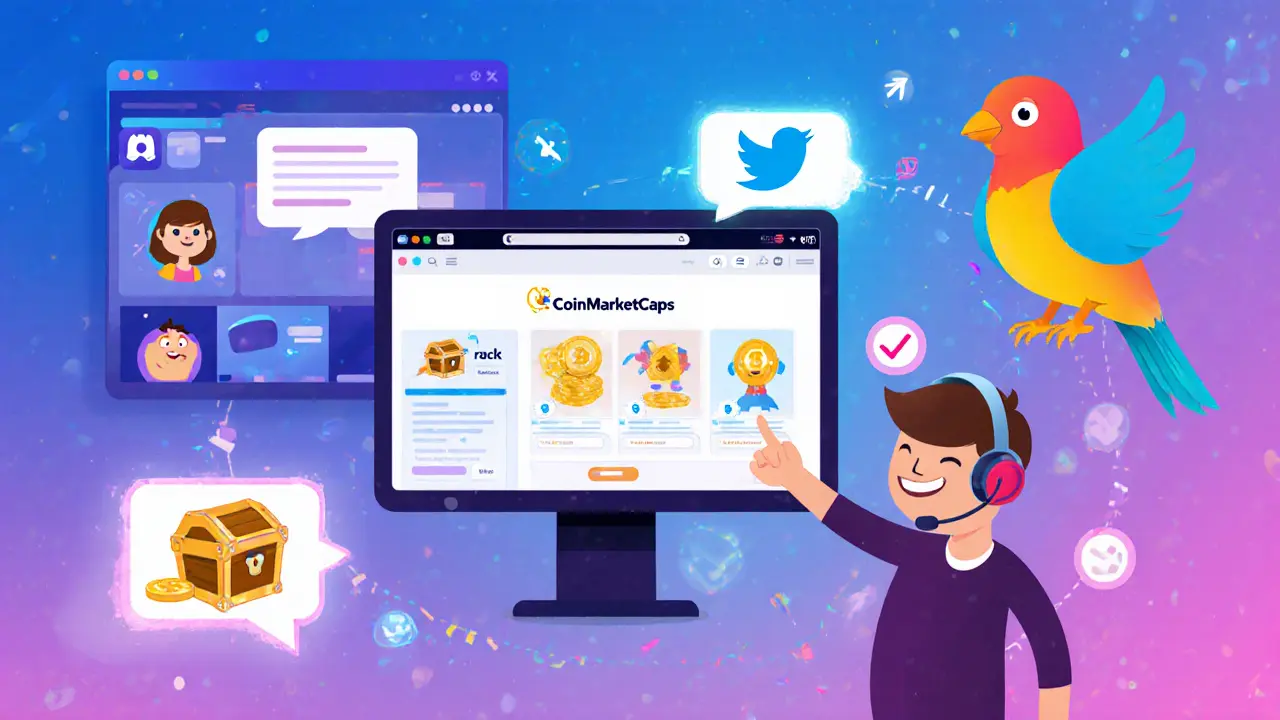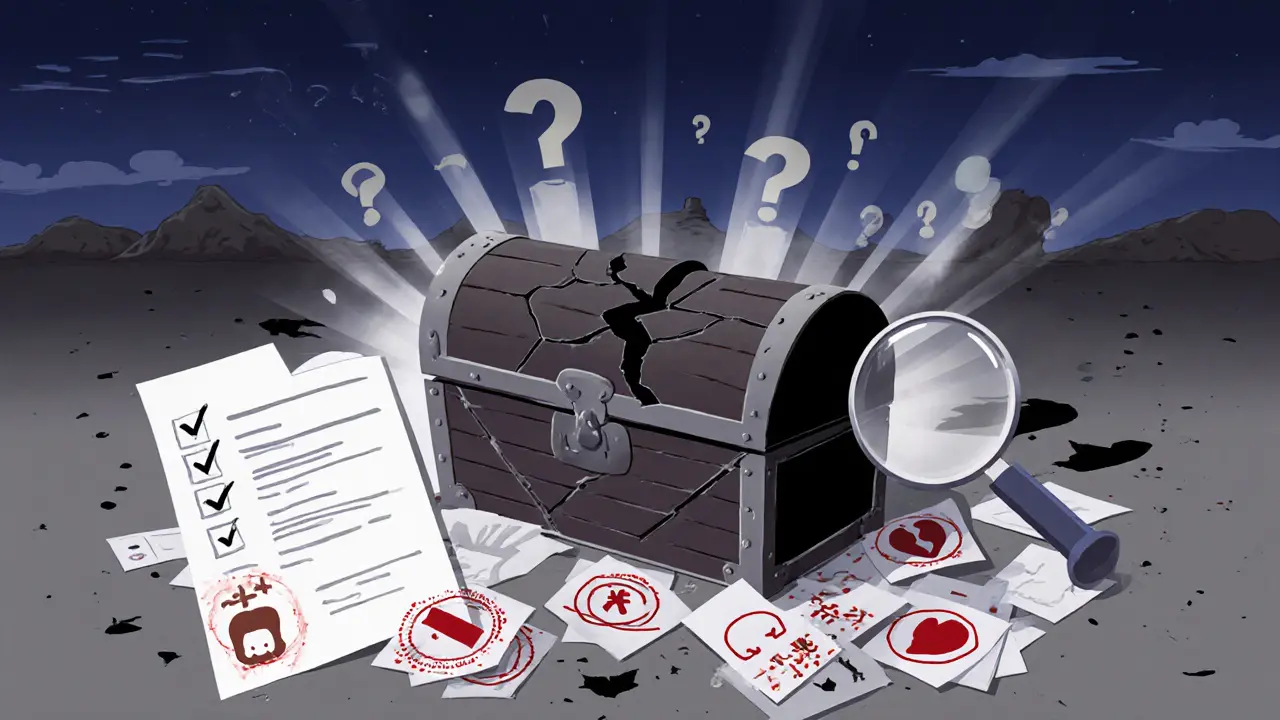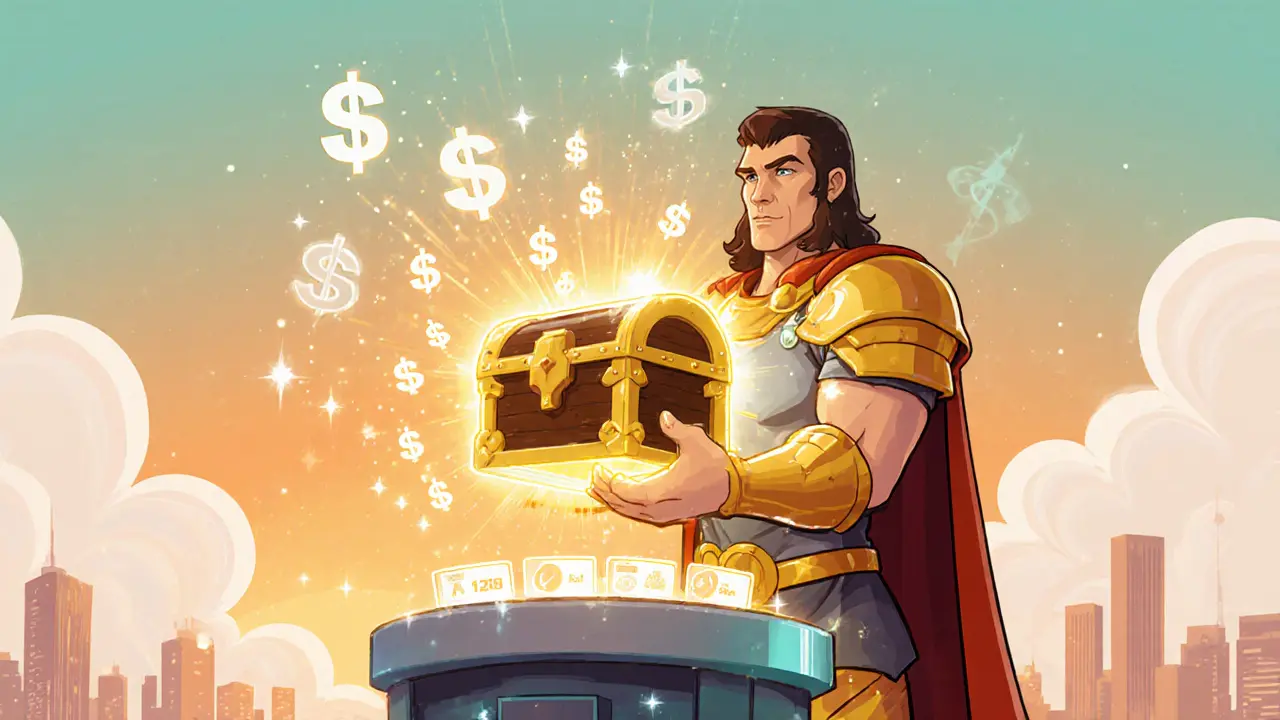Battle Hero II Airdrop Prize Calculator
Estimated Total Value
Enter values and click Calculate
Prize Pool Breakdown
| Item Type | Approx. Value (USD) | Quantity |
|---|---|---|
| Gold-tier NFT Chest | $500 | 20 |
| Silver-tier NFT Chest | $200 | 50 |
| Bronze-tier NFT Chest | $50 | 200 |
| Native token (BHT) | $0.10 per token | ~150,000 |
Quick Summary
- Battle Hero II ran a $50,000 Chest NFT airdrop in early 2022.
- The event was listed on CoinMarketCap’s airdrop page and required users to complete small tasks.
- Researchers warned that the project lacked transparent tokenomics and team details.
- Current activity around Battle Hero II is unclear; the website and socials show little recent engagement.
- When evaluating similar airdrops, focus on verified team info, clear token utility, and community health.
If you’ve been searching for a clear rundown of the Battle Hero II Chest NFTs airdrop, you’re in the right spot. Below we unpack what the airdrop promised, how it was advertised, the red flags that popped up, and what you should look for before chasing the next free‑token offer.
What Is Battle Hero II?
Battle Hero II is a play‑to‑earn blockchain game that lets players collect, upgrade, and battle hero characters using NFTs. Launched in 2021, the game positions itself in the NFT gaming boom, offering loot‑box‑style rewards and a native token meant to fuel in‑game transactions.
The game’s core loop revolves around NFT chest digital containers that can be opened for random hero gear, experience boosts, or token payouts. While the exact smart‑contract details are not publicly audited, the chest mechanic is marketed as a way to earn value beyond pure gameplay.
Overview of the Chest NFTs Airdrop
Battle Hero II Chest NFTs Airdrop was a token distribution event announced in early 2022, promising a total prize pool of over $50,000 in various NFT chests and native tokens. The airdrop was positioned as a community‑building push, aiming to attract new players and reward early adopters.
Promotional material first appeared on February 28, 2022 when crypto influencers began dissecting the offer. The campaign leveraged the credibility of CoinMarketCap’s airdrop platform, which at the time listed hundreds of token giveaways across the ecosystem.
How the Airdrop Was Promoted
The primary channel for the giveaway was the CoinMarketCap a widely used cryptocurrency data site that also hosts a dedicated airdrop portal. On the portal, users were instructed to:
- Join the official Battle Hero II Discord.
- Follow the project on Twitter and retweet a pinned announcement.
- Submit a valid crypto wallet address (usually an ERC‑20 compatible address).
- Complete a brief survey confirming interest in play‑to‑earn games.
Each completed step gave the participant an entry ticket, with a higher chance of receiving a “gold‑tier” chest if all tasks were finished.

Reported Mechanics and Eligibility
While the exact distribution algorithm was never published, community members pieced together a likely model based on the task list and the $50,000 prize pool:
- Basic eligibility: Anyone with a valid Ethereum address could apply.
- Tiered rewards: Users who completed all four tasks were placed in a “premium” pool for higher‑value chests.
- Randomized draws: Winners were selected via a smart‑contract‑based random function, though the contract address was never openly verified.
- Distribution timeline: The airdrop window closed in March 2022, with claims expected within two weeks after the draw.
Because the smart contract code was not audited, many participants expressed uncertainty about whether the chests would actually be minted to their wallets.
Prize Pool and Value
The promotional banner advertised a total value of “over $50,000”. The pool consisted of:
| Item Type | Approx. Value (USD) | Quantity |
|---|---|---|
| Gold‑tier NFT Chest | $500 | 20 |
| Silver‑tier NFT Chest | $200 | 50 |
| Bronze‑tier NFT Chest | $50 | 200 |
| Native token (BHT) | $0.10 per token | ~150,000 |
These numbers are based on community‑sourced screenshots; the official audit never surfaced, so the exact figures remain speculative.
Risks and Red Flags
Crypto researchers who examined the airdrop early on issued a clear warning: “extreme caution” is advised when participating in any unverified token giveaway. The main concerns were:
- Lack of team transparency: No verifiable LinkedIn profiles, office address, or audited whitepaper were available.
- Unclear tokenomics: The native token’s utility inside the game was described in vague terms, making it hard to assess long‑term demand.
- No audited smart contract: Without a public contract audit, the randomness and distribution fairness could not be guaranteed.
- Limited post‑airdrop activity: After March 2022, the project’s Discord activity dropped sharply, and the website became intermittently reachable.
These red flags match a broader pattern observed during the 2021‑2022 NFT gaming surge, where many projects launched flashy airdrops only to fade away months later.
Current Status of Battle Hero II
As of October 2025, reliable data on Battle HeroII is scarce. Attempts to pull metrics from mainstream trackers (CoinGecko, DappRadar) return “no data”. The Discord server shows fewer than 200 active members, and the last official tweet dates back to mid‑2023. There is no public roadmap or recent development updates, suggesting the project may be dormant or operating on a very low scale.
If you’re still holding a chest NFT from the airdrop, you’ll likely need to contact the project’s support email (if it still works) to claim any remaining rewards. Otherwise, the token value may have depreciated to near zero.
How to Evaluate Similar Airdrops
Even though the Battle HeroII case is older, the lessons still apply. Use this quick checklist before you click “Join Airdrop” on any new campaign:
- Team verification: Look for LinkedIn profiles, GitHub activity, and reputable advisors.
- Smart‑contract audit: Confirm that an independent firm (e.g., CertiK, Quantstamp) has signed off on the contract.
- Clear token utility: Ask how the token will be used within the ecosystem beyond speculation.
- Transparent prize pool: A detailed breakdown (like the table above) adds credibility.
- Active community: Check Discord, Telegram, and social media for regular updates.
- Regulatory compliance: Ensure the project isn’t promising guaranteed returns, which can breach securities laws.
Following this framework will help you avoid the pitfalls that plagued many 2022 NFT gaming airdrops, including the Battle HeroII distribution.

Frequently Asked Questions
Was the Battle Hero II airdrop a scam?
There is no definitive proof of fraud, but the lack of audited contracts, opaque team details, and dwindling community activity suggest a high risk. Participants should treat it as a speculative giveaway rather than a guaranteed investment.
How could I have claimed my chest NFT?
The original claim process required linking an Ethereum wallet on the CoinMarketCap airdrop page, then awaiting a transaction that minted the chest to your address. If you missed the window, the tokens were likely returned to the project’s reserve.
What does “play‑to‑earn” really mean?
Play‑to‑earn describes games where in‑game actions generate blockchain‑based assets (tokens or NFTs) that can be traded or sold for fiat/crypto. The model relies on a strong in‑game economy and real demand for the assets.
Is it worth keeping a Battle Hero II chest NFT now?
Given the project’s inactivity and lack of secondary market listings, the chest’s resale value is likely negligible. Unless the team revives development, holding it probably won’t yield any return.
Where can I find reliable airdrop listings?
Stick to platforms that require contract audits and display clear eligibility criteria - examples include CoinMarketCap’s vetted section, AirdropAlert, and official project channels that link to a public GitHub repo.


Ever notice how every "cash‑grab" airdrop pops up just when the market's about to dip? The Battle Hero II chest distribution looks like one of those engineered hype cycles, a perfect storm to siphon unsuspecting wallets. It’s almost as if someone’s pulling the strings behind the scenes, waiting for the next wave of eager gamers to fall into the trap.
Totally get the anxiety, but keep in mind that not every project is a scam. The tokenomics offered here could actually bring some utility if the devs ever deliver a solid roadmap. Think of it as a lesson in critical thinking-question the red flags, yet stay open to genuine innovation. The community’s response can be a good barometer for future success. 🙂
I hear you, and it’s easy to feel burnt after a hype‑filled airdrop fizzles out. The lack of audit definitely raises eyebrows, but remember that many early‑stage games learn from these missteps. If the team ever revives the Discord and shares transparent updates, that could reignite confidence. Until then, treating the chest NFTs as collectibles rather than investments might save some heartbreak.
From a risk assessment standpoint, the smart‑contract opacity translates to a high variance beta‑factor, essentially rendering the expected return function undefined. Without a certi‑K audit, the stochastic distribution algorithm remains a black‑box, undermining any meaningful utility.
Honestly, I just skim the FAQ and see that the prize pool numbers sound nice on paper, but the real test is whether anyone can actually claim them. If the website’s down and the Discord is quiet, that’s a pretty solid hint that the project might be dormant.
Listen up, folks-this post is a wake‑up call! The Battle Hero II airdrop was marketed with glittering gold‑tier chests, yet the underlying fundamentals were as thin as a paper‑thin smart contract! First, the team never revealed any verifiable identities, which is a massive red flag in the crypto world! Second, no independent audit means the randomness mechanism could be rigged, steering rewards to insider wallets! Third, the tokenomics lacked clear utility, so even if you got BHT tokens, there’s no real demand driving price appreciation! Fourth, the post‑airdrop activity plummeted, with Discord members dropping below two hundred-hardly a thriving community! Fifth, the official website became intermittently reachable, suggesting possible abandonment! Sixth, the claimed $50,000 prize pool was never substantiated by on‑chain data-just screenshots and hype! Seventh, the claim process required linking an Ethereum address on a third‑party portal, exposing users to phishing risks! Eighth, the “random draw” was never tied to a transparent contract, leaving room for manipulation! Ninth, the lack of a roadmap means there’s no plan to integrate those chests into actual gameplay! Tenth, even the native token BHT was priced at a penny with no clear use case beyond speculative trading! Eleventh, the community’s silence after March 2022 indicates that the project may have been a flash‑in‑the‑pan venture! Twelfth, investors should demand audited contracts before committing any assets! Thirteenth, always verify the team’s LinkedIn or GitHub presence! Fourteenth, check for reputable advisors backing the project! Fifteenth, use reputable airdrop platforms that enforce strict compliance! In short, treat this airdrop as a cautionary tale and stay vigilant!
When performing a comprehensive due‑diligence audit of the Battle Hero II initiative, one must consider multiple vectors of systemic failure that collectively erode any semblance of investor confidence. The first vector pertains to governance opacity; the absence of a disclosed executive board violates basic corporate transparency standards. The second vector is technical inadequacy: the smart‑contract architecture was never subjected to a third‑party security audit, thereby introducing a non‑trivial probability of exploitable vulnerabilities. Third, the economic model suffers from severe inflationary pressure, as the token emission schedule lacks a capping mechanism, effectively diluting token value over time. Fourth, the community engagement metrics demonstrate a precipitous decline, with daily active users falling below the threshold required to sustain network effects. Fifth, the promotional strategy relied heavily on influencer amplification rather than substantive product milestones, indicating a marketing‑first, product‑later philosophy. Sixth, the prize allocation matrix was disclosed solely through visual assets, eschewing any verifiable on‑chain proof of reserve backing. Seventh, the reliance on a centralized airdrop aggregator introduces an additional layer of custodial risk, as users must trust the aggregator’s integrity. Eighth, the lack of a clear roadmap or development timeline renders any forward‑looking valuation speculative at best. Ninth, the token’s utility is confined to in‑game transactions, yet the game's adoption itself appears stagnant, thereby limiting demand for the token. Tenth, the legal compliance posture is ambiguous, raising potential regulatory exposure in multiple jurisdictions. Eleventh, the token’s liquidity pool is illiquid, with negligible trading volume on reputable exchanges, further compounding exit risk. Twelfth, the project's social media cadence has been sporadic, undermining community trust. Thirteenth, the project's whitepaper remains unlinked, depriving analysts of a foundational technical reference. Fourteenth, the deployment of NFTs without a clearly defined royalty structure adds uncertainty to secondary market dynamics. Finally, aggregating these systemic deficiencies yields a risk‑adjusted profile that is decidedly unfavorable for prudent participants.
Emily’s points hit the nail on the head-especially the lack of audit and community fade‑out. Even seasoned investors should flag such projects before allocating capital. The red flags compound quickly when you stack them together.
Absolutely, the convergence of those warning signs makes the airdrop a textbook example of a high‑risk giveaway. It also underscores why thorough research is non‑negotiable. If you’re still curious, focus on projects with transparent tokenomics and active dev teams.
Looks like a classic NFT hype dump.
One might argue that the very notion of “value” in these airdrops is a construct of collective belief, yet when the scaffolding of that belief crumbles, the perceived worth evaporates. The epistemological gap between promised utility and delivered functionality is glaring. Moreover, the absence of auditable mechanisms betrays a deeper ontological uncertainty about the project's existence. In this light, the Battle Hero II episode serves as a cautionary paradigm for discerning digital alchemy from genuine ecosystem building. Ultimately, rational actors should demand empirical evidence before surrendering assets to speculative vessels.
Oh sure, because we all love tossing our hard‑earned crypto into a game that barely has a Twitter account. It’s not like the US regulators are watching or anything. And hey, if the project disappears, who’s to blame? Definitely not the community that was duped.
The checklist in the article is solid-team verification, audit, utility, roadmap, and community health are the cornerstones of a trustworthy airdrop. Applying that framework can save you from chasing ghosts like Battle Hero II.
I appreciate the thorough breakdown; it’s a reminder that enthusiasm should be paired with diligence. If developers revive the game and provide transparent updates, there could still be a chance for redemption. Until then, treating the NFTs as collectibles rather than investments might be the safest play.
It is morally incumbent upon us, as participants in the crypto ecosystem, to hold projects accountable for their promises. When a venture like Battle Hero II fails to deliver on its publicly advertised bounty, it erodes trust not only in that specific token but also in the broader decentralized finance movement. The community must demand higher standards of transparency, especially regarding tokenomics and audit disclosures. Without such vigilance, we risk normalizing deceptive practices that prey on uninformed investors. Ethical stewardship starts with questioning every airdrop that lacks clear, verifiable documentation.
The analysis presented offers a comprehensive overview of the pitfalls associated with this airdrop. It serves as a valuable guide for both newcomers and seasoned participants. Maintaining a critical eye towards project fundamentals remains essential.
Sounds like a rough ride, but every setback teaches us something. Keep an eye on projects that actually deliver on their roadmaps, and you’ll find better opportunities. Stay positive and keep learning!